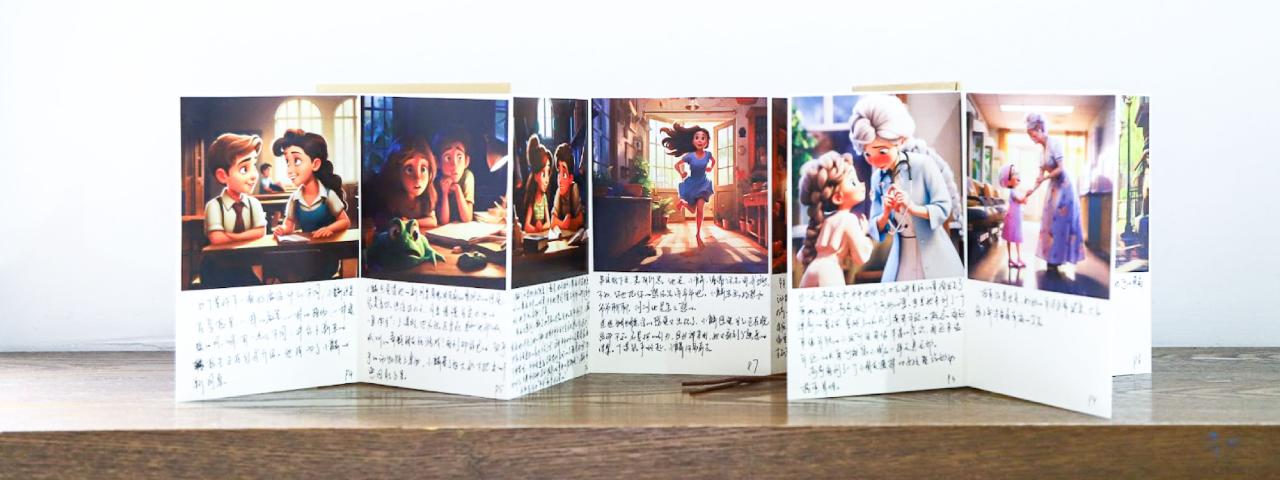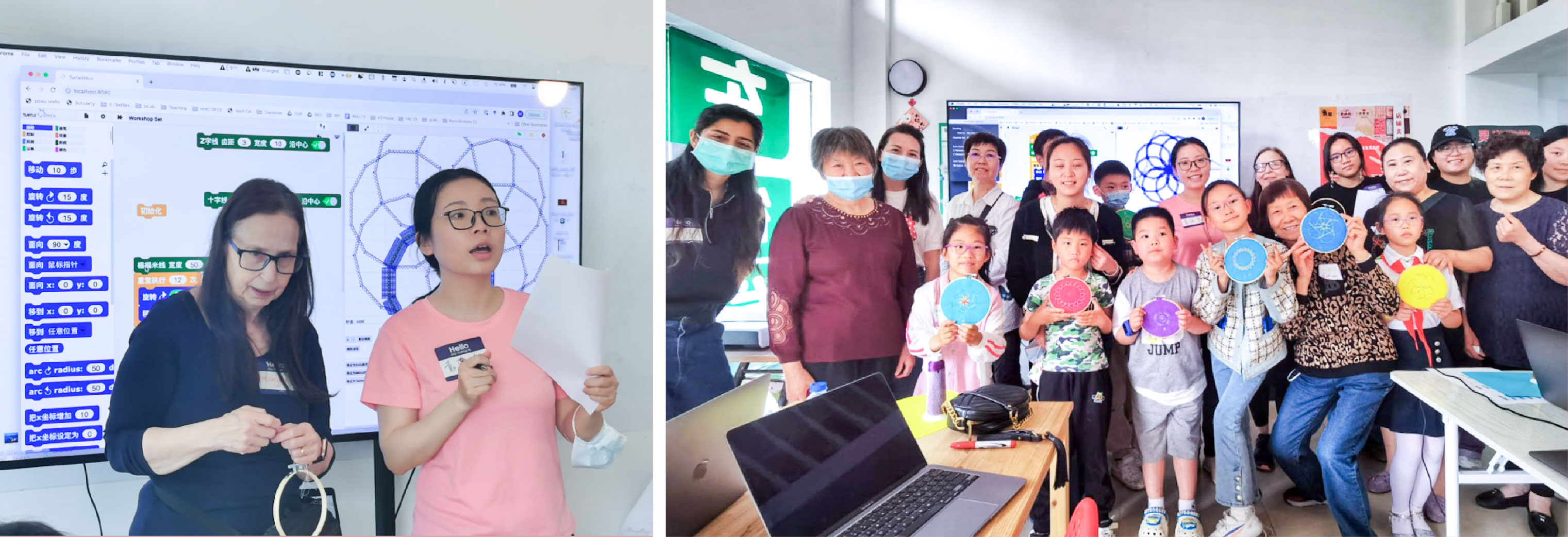
At NYU Shanghai, Yuan Yanyue, assistant professor of Interactive Media and Business, has taught Design Thinking, Experience Studio sections on ‘Participatory Design’ and ‘Shaping the Futures of Aging,’ Communicating For Influence, and Entrepreneurship Explored to college students. But it’s the younger and elderly demographics who have inspired the heart of her current research on intergenerational creative learning. Yuan says she’s made it her lifelong pursuit to design spaces and experiences that enrich connections and collaborations between young and old generations, starting from her practices focusing on the urban context of Shanghai.
Over the summer, Yuan facilitated a picture book workshop series called “Ageless Planet,” where multi-generational participants teamed up to discuss topics of age, family, friends, self, and society while co-creating their own unique stories on the subject, using the generative artificial intelligence program Midjourey to create their story illustrations. She then presented her observations and experience at a public seminar called “Learning across generations: towards an age-friendly Shanghai.”
This isn’t Yuan’s first venture into creating intergenerational learning resources and experiences. She’s been piloting workshops since 2019, bringing grandparents and grandchildren together over collaborative storytelling, collage making, LEGO-building, and she even designed a card game that invites older and younger players to get to know each other by completing engaging tasks.

Left: A Grandparent-grandchild pair introduces their creation during an intergenerational collage-making workshop led by Yuan at a community center in August, 2019. Right: Using LEGO bricks, older adults build their own creative works at a community center workshop that Yanyue facilitated with students Mi Zhou and Linhui Wu as their DURF project, in August, 2018.
Left: Grandparents and grandchildren pair up for a drawing warm-up exercise during the intergenerational collage-making workshop led by Yuan in August, 2019. Right: Intergenerational Storytelling Workshop led by Yuan at the Being Art Museum in July, 2020.

How did intergenerational creative learning become your main research focus?
I have a background in designing family workshops and workshops for children and adults in museum settings…[and] this idea of intergenerational learning is based on a lot of my personal observations. There’s already a lot of research on how urban design segregates people from different age groups. For example, in a lot of parks in China, we might expect to see mostly Chinese elderly people square dancing or doing exercises, while children can be found in learning spaces or playgrounds targeted towards this particular age group. I noticed a lot of grandparents and parents were very bored while they waited for their children to finish taking some courses or playing. You see them taking a nap or scrolling on their phone, and it’s not a very healthy life. I believe everyone should be able to enjoy their time at their own pace in public spaces, instead of a space only serving one group.
I started to notice that the grandparents and parents who accompanied children to these workshops might benefit from being a part of it, not just solely serving their child or grandchild’s growth. From my teaching, reading, and personal experiences, I started to develop an interest in designing experiences with the goal of facilitating and supporting creative learning and self-directed learning across the lifespan. That is to say, I have widened my previous research interest in fostering creative learning in informal learning settings with a primary focus on children and young adults to lifelong and lifewide learning for all ages. I want to challenge myself by first exploring how I could design learning experiences to bring people together from skipped generations (grandparents and grandchildren).
I applied for funding from the Shanghai Social Science and Philosophy Planning office, which offers funding to young scholars to support different types of social science research projects.
What do participants experience in the “Ageless Planet” workshop series?
In the first two activities of the workshop series, elderly people and children participated in a series of self-introduction warm-ups and story-sharing and got a preliminary understanding of the process of image creation with Midjourney. In the third workshop, they came together for ice-breakers, topic discussions, story creation, and picture book design.
People are always saying, "I can not draw," but they actually have a lot of ideas that they hope to share with others using visual aids, and 2023 is the year where AIGC (generative artificial intelligence) became so popular and so accessible. That’s what inspired my team of student research assistants and I to design this series of three workshops together.
What was the storyboard structure you gave them to collaborate on?
The story framework they are given is: an older person had a fight with a younger kid. The group–two elderly people and two to three children–has to create a story based on a number of prompts: who are the characters? Why are they having a fight? Where are they? Then there's the transition period, where each of the characters had a magic dream. In this dream, they found themselves on an “ageless planet,” where you could not discern how old people are by just looking at them. In the end, the characters woke up, and the fight was resolved.

Storyboard structure for the "Ageless Planet" workshop
What did you observe and experience during the workshops, and how has that informed your research going forward?
During this picture book creation, we noticed children are very excited about selecting the picture style for Midjourney prompts. The children would say, “I'm picking Disney,” and then their grandparents would say, “Okay, we'll adopt this idea.”
You have these two groups from drastically different age groups (who did not know each other before the workshop) mingling together, and because it's creative work, everyone has a very strong opinion. One group in particular had a little disagreement while creating the story, and even about which final image they should pick after they were provided with four images generated by Midjourney.
The two-hour workshop was really a challenge, and the four research assistants, as the middle generation, put in much more effort than expected when assisting the full process.
I would say this was a very bold experiment, and my long-term vision is to actually have this community sense of an age-friendly learning community, so that people can learn from elderly people outside of their own family. I realized that to facilitate intergenerational learning, we don't have to bring everyone together at the same time and same place. They can be involved in the same product, but from different angles and at different times, in a way that best fits their needs and learning habits. For example, the children can come up with a story idea, and the older people can add in their own elements. They each could use their own spare time to listen and look at each other’s work in progress, allowing them the capacity and flexibility to see what the other age group is most capable of doing.
What I'm going to try to do in the future is to have more collaboration with others, because as I saw through the public seminar this summer, there are actually people who work at different levels and different formats on this topic.
Do you have any other upcoming research plans?
I'm going to collaborate with Margaret Minsky, another NYU Shanghai faculty who specializes in computational coding language. We have an age-friendly workshop where you can use a very simple coding language, Turtlestitch, linked to a sewing machine that will stitch out a pattern.
When we tested this workshop at a nearby community center, I encountered a number of unexpected challenges. Each pair was given one laptop, and we noticed that basically the children always dominated the laptop. We [were] trying to encourage one grandmother to use the laptop, and her granddaughter said, “She doesn't know anything about this; I should do this.” The grandparents had no sense of involvement till the very end, when we asked them to pick the color of the felt and the color of the thread–only then they had so much to share about their aesthetic opinion while sharing their own memories and history of hand stitching.

Yuan and Minsky leading a pilot workshop at Dongming Community Center where children and their grandparents collaborated on their own embroidered works using a coding language called Turtlestitch. (May, 2023).
[In the future,] when we are actually introducing this series of workshops together, we want to not just use this as an artistic format for learning coding language, but to actually integrate [the elderly’s] own life stories to make it more meaningful.
Next year, I will also be creating a beta version of a learning toolkit for intergenerational family or friends groups when they visit museums and cultural sites. In addition, I will be collaborating with Yangjing Memory Cafe in my Experience Studio course section ‘Shaping the Futures of Aging,’ in Spring 2024, to guide our students to work on the ‘Life Book’ project–a book that documents an older family member’s life habits, preferences, and significant life moments so that it serves as a great family souvenir and can be a reference point in case the person develops Alzheimer’s in the future.
With the rapid advancement of generative AI, I will be keeping alert with any opportunities that AI can offer my future research designs and workshops.

Learn more about Yuan Yanyue’s “‘Ageless Planet’ Intergenerational AI Picture Book Co-creation” project in an exhibition displayed on the fifth floor (near W502 and W512) outside of NYU Shanghai’s Library from November 17 until December 15.

